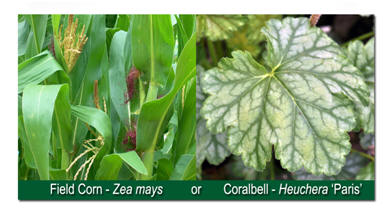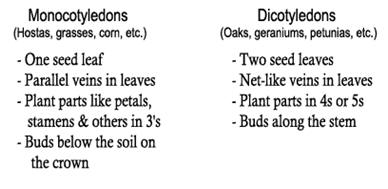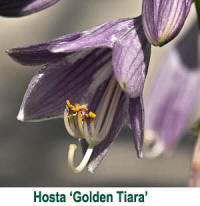Look at the hostas in your garden and guess
whether they are more closely related to field corn (Zea mays)
and Kentucky bluegrass (Poa) or to plants like Coralbells (Heuchera)
and rhubarb (Rheum). With their often very large, roundish
leaves, most people would probably say that hostas are more closely
related to rhubarb than to grass. Unfortunately, they would be
wrong.

All vascular plants can be divided into two
broad categories: Monocotyledons a.k.a. monocots and Dicotyledons
a.k.a. dicots. Hostas are monocotyledons. This group includes all
the grasses but other plants that look quite different, such as
hostas, are also monocots.
The following chart compares the major traits
of the two groups:

One key point between the two groups of plants
concerns the location of buds which can lead to new growth. In the
monocots like hostas, if you cut off the leaf blade, a new one will
NOT form on the remaining stalk. The leaf stem i.e. petiole, has to
be cut down to ground level to trigger the formation of a new bud on
the hosta's underground crown which may then send up a new leaf.

On dicots such as petunias, if you cut off a
leaf, that may trigger a new bud located on the stem to open and
form a new leaf. This is the reason for "pinching" such plants to
form a thicker, denser canopy of foliage. Pruning dicot trees will
cause nearby buds on the stem to break and produce new twigs and
stems.
 Since hostas are monocots, they bear their
plant parts in groups of three. The showy part of the flower which
would normally be called petals are actually tepals on hostas. Tepal
is the term for the combination of the sepals (the green modified
leaves that cover the petals while in bud) and the actual petals of
the flower. There are normally 6 tepals in a hosta flower along with
six stamens (male parts) and three carpels or ovaries in the pistil (female
parts).
Since hostas are monocots, they bear their
plant parts in groups of three. The showy part of the flower which
would normally be called petals are actually tepals on hostas. Tepal
is the term for the combination of the sepals (the green modified
leaves that cover the petals while in bud) and the actual petals of
the flower. There are normally 6 tepals in a hosta flower along with
six stamens (male parts) and three carpels or ovaries in the pistil (female
parts).



